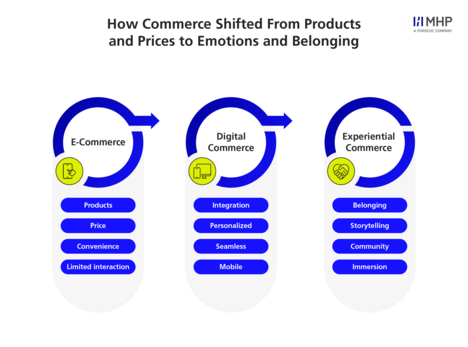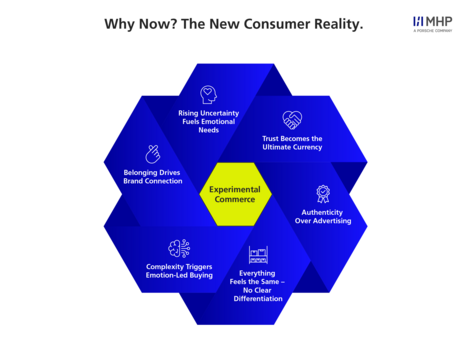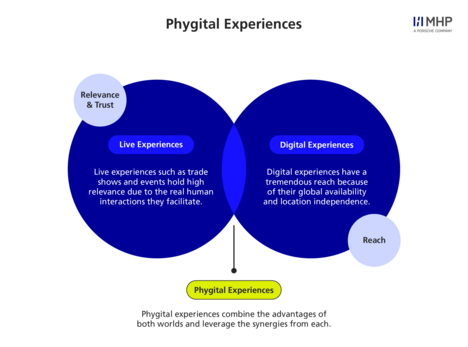
- Blog, Customer Experience & Sales
- Published on: 06.10.2025
- 6:57 min
How Experiential Commerce is Reinventing Retail
Online shopping has never been more convenient. Products are just a few clicks away, supply chains are optimized, and payment processes are largely automated. However, the more efficient these processes become, the more interchangeable the experience feels. Filling a digital shopping cart often leaves customers feeling anonymous and emotionally unaffected. Meaningless transactions have become the norm.
At the same time, consumers live in a world defined by instability, information overload, and rapid technological change. In this BANI (brittle, anxious, nonlinear, and incomprehensible) world, uncertainty and disorientation are rising, as is the need for genuine experiences, trust, and belonging. According to one study, 83% of consumers say that a positive live experience creates a stronger emotional connection to a brand.
Experiential commerce is a strategic approach that reimagines retail as a holistic brand experience, not just a sales platform. Companies that infuse their brand with emotion build loyalty, not just sales. Today, it's not just what people buy that matters, but also why they buy it and where they feel a sense of belonging.
From Products to Belonging: The Evolution of Commerce
Digital retail models have rapidly evolved in recent years, progressing from basic e-commerce to integrated digital commerce experiences and, finally, to a comprehensive approach that redefines customer expectations. While traditional e-commerce primarily focuses on price, product selection, and speed, digital commerce emphasizes seamless integration, personalization, and a consistent omnichannel customer journey. The ne
ommunity, and immersive experiences. Instead of merely selling products, brands foster relationships. Rather than optimizing touchpoints in isolation, a curated customer experience emerges that meaningfully connects all interactions. This new form of commerce responds to the emotional needs of a complex world, fostering identification rather than comparability.
The following graphic illustrates how commerce has evolved along this trajectory:
Current State: Interchangeability Despite Technology
Digital retail has made enormous progress in recent years. Standardized platforms, algorithm-driven product recommendations, and one-click checkouts provide efficiency, speed, and convenience. However, the digital shopping experience is functionally optimized yet emotionally hollow.
Price, selection, and convenience have long been considered basic requirements. Competition increasingly takes place on platforms whose interfaces are visually, technically, and content-wise very similar. What remains is commerce that offers little recognition or distinction. Switching products or brands is often just a tab away.
For many companies, this creates a strategic gap:
- How can attention be captured amidst uniformity?
- How can differentiation beyond the product be achieved?
- And how can genuine customer loyalty develop when interchangeability is the norm?
To succeed in this environment, new tools and touchpoints alone are insufficient. A paradigm shift is required, moving away from transactional thinking and toward a brand strategy that defines relevance through experiences, emotions, and belonging.
This is exactly where experiential commerce comes in. In a reality shaped by uncertainty, complexity, and a lack of differentiation, emotional needs, authenticity, and community take center stage. The following visualization shows the dynamics that shape today’s consumer behavior and explains why brands must focus on real experiences.
Understanding Experiential Commerce: Principles and Potential
Experiential commerce is the logical response to a technically advanced but often emotionally empty retail world. Today, reaching a loyal audience requires more than just functionality. The goal is to transform brands into providers of experiences and customers into participants in a world, not merely buyers of a product.
This is not just about creating an atmospheric marketing approach; it's about strategic realignment. At the core, emotional connection replaces purely functional benefits. Consumers don't just buy a product; they consciously choose a brand, stance, or narrative with which they can identify.
While the path to this goal is as unique as each brand, key success principles can be identified. These principles form the foundation of experiential commerce, showing how digital and physical touchpoints can be transformed into emotional brand experiences.
Phygital experiences combine physical and digital elements to merge the advantages of both worlds. The following visualization shows why their synergy makes all the difference.
Based on this, six central building blocks can be identified to guide brands and enable an experience-driven commerce strategy.
- Storytelling and purpose: Meaning is created through stories and a clear stance.
- Community and co-creation: Interaction fosters loyalty and allows customers to actively participate.
- Immersive experiences: Technology enables deep experiences, from augmented reality to virtual flagship stores.
- Interactive engagement: Elements like live streams, gamification, and challenges encourage active participation and strengthen the connection to the brand.
- Personalization and contextualization: Data-driven offerings make each interaction more relevant.
- Frictionless journeys: Smooth processes allow you to focus on what matters most: the experience itself.
Each of these building blocks contributes to differentiation in its own way. Together, they form a new retail logic that makes brands more visible and tangible.
Practical Examples: How Brands Create Experiences
Brands are opening up spaces where customers can actively participate, whether through sustainable initiatives, digital innovations or community formats. The following examples illustrate the variety of ways in which this approach is being implemented.
1. Patagonia: A brand as a living statement
Patagonia brings its values to life through sustainable retail experiences. One notable example is the “Worn Wear” program, which includes pop-up tours, an online platform, and a repair service. Through this program, customers can send in used Patagonia clothing to be repaired and passed on. This initiative strengthens emotional brand loyalty and fosters a community around values such as durability and environmental responsibility. Additionally, Patagonia designs each store differently, connecting physical spaces with regional identity and events.
2. Lego: Co-creation, AR, and a moving community
Lego enhances the in-store experience through augmented reality and community engagement. In the “Hidden Side” line, physical LEGO sets merged with digital, interactive ghost adventures via an app. LEGO Ideas also promotes co-creation by allowing fans to submit their own set ideas, which may be produced and marketed if they receive enough support. At the LEGO House in Billund, Denmark, visitors experience an interactive brand world that appeals to all age groups. Attractions such as a robotics lab and the digital game “Fish Designer” encourage guests to explore technology and creativity playfully.
3. Burberry: Luxury meets digital interactivity
Burberry positions itself as a pioneer of phygital luxury experiences. At the Social Retail Store in Shenzhen, the brand combines physical store visits with digital interaction via a WeChat mini program. Customers receive a virtual Fawn avatar, collect “social currency”, book styling sessions, and receive personalized recommendations. Additionally, Burberry uses augmented reality to project products, such as the TB bag or sneakers, into customers' own spaces via Google Search or QR codes. The brand also brings products to life in AR web experiences at pop-ups without requiring an app.
MHP as an Enabler for Experiential Commerce
Experiential commerce begins with a new perspective on customers. Companies that want to drive this change need creative ideas and a clear roadmap. They also require a partner who can support the transformation on strategic, technological, and operational levels. This is where MHP comes in.
As a business and technology partner, MHP helps companies create consistent, brand-defining experiences, from vision to scalable platform architecture. The focus is always on one question: How can a transactional process become a meaningful moment? Ad how can this quality be made reproducible and measurable across all touchpoints?
MHP brings three core competencies to the table:
- Strategic consulting and vision development: Together with the client, MHP develops an individualized experience vision with clear market differentiation, relevant brand positioning, and measurable customer loyalty.
- Experience-centered journey design: Customer journeys are designed around relationships, not products. MHP takes the perspective of the target audience and connects digital and physical touchpoints into coherent experience chains.
- Modular commerce architecture and technological implementation: MHP designs and implements scalable platforms that enable personalization, real-time interaction, and phygital experiences, including AI-based context recognition and automated content logic, whether headless, API-first, or cloud-based.
What sets MHP apart is its ability to combine technological excellence with emotional relevance. The result is not an off-the-shelf commerce solution. Rather, a custom-developed experience ecosystem emerges that is strategically designed, technologically advanced, and built for long-term security.
Conclusion: Relevance is Created Through Experience
Growing interchangeability in digital retail is not an inevitable fate, but rather an invitation to change. To stand out today, brands must offer more than process efficiency or product variety. What matters are meaning, relationships, and experience.
Experiential commerce delivers exactly that, offering a forward-looking approach that views people as more than just consumers; it sees them as part of a brand world. Brands that engage, move, and inspire their customers create true differentiation through emotional relevance.
MHP supports companies on this journey with strategic foresight, technological excellence, and a deep understanding of tomorrow’s challenges. Together, we transform digital commerce into a sustainable brand experience that strengthens brands and connects with customers.
FAQ
Experiential commerce goes beyond purely transactional digital purchasing processes. Rather than focusing on the product, the focus is on the experience. Brands establish emotional connections by fostering a sense of belonging, purpose, and interaction. While digital commerce focuses on efficiency and scale, experiential commerce prioritizes relationships, meaning, and brand loyalty.
The key is holistic experience design conceived across all channels, integrating physical and digital touchpoints from the beginning. Modular commerce architectures and intelligent data logic create a consistent, context-based brand world that adapts flexibly to each customer situation, both online and offline.
Experiences create attention, trust, loyalty, and recognition. These factors are key to long-term brand success. Companies that focus on brand experience can demonstrate an increase in customer loyalty, engagement time, and willingness to recommend. Metrics such as Net Promoter Score (NPS), Customer Lifetime Value (CLV), and interaction rates allow companies to measure and manage their impact effectively.




